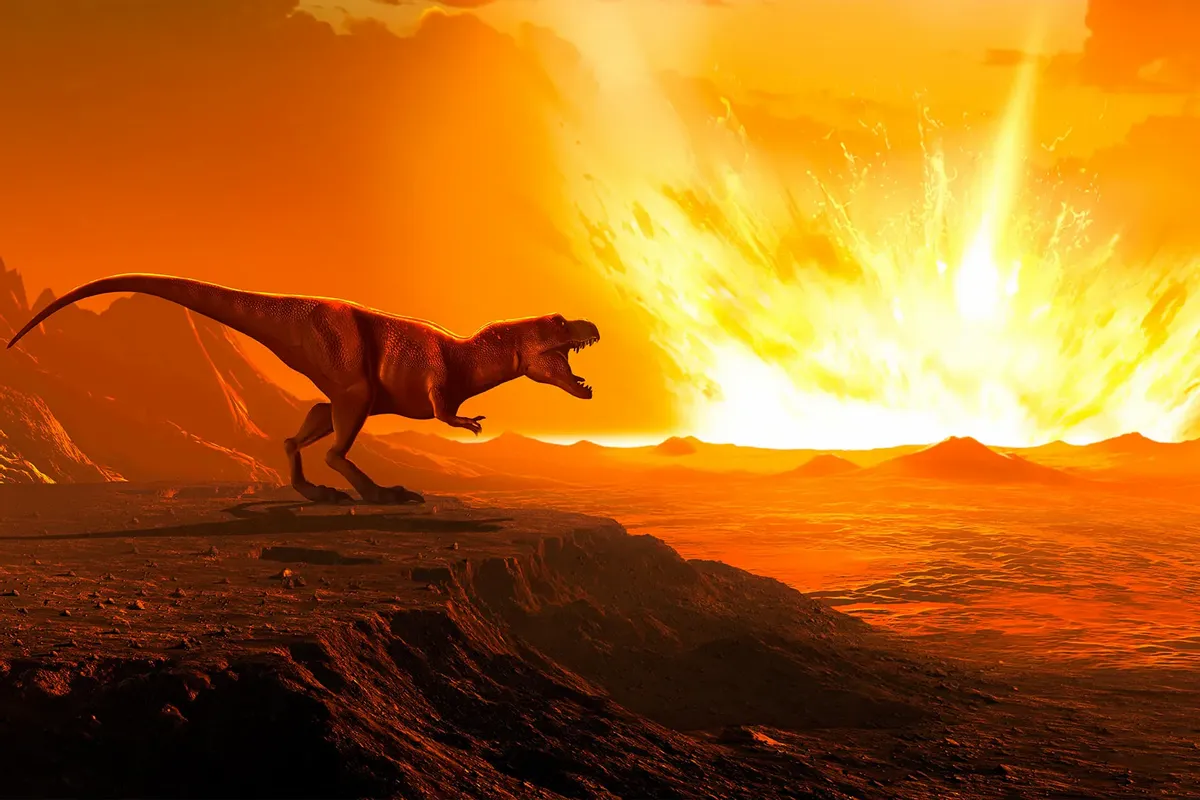Sixty-six million years ago, a flaming asteroid collided with our planet, triggering one of the most devastating events in Earth’s history: the Cretaceous-Paleogene (K-Pg) Extinction. This event quickly wreaked havoc on Earth’s ecosystems, wiping out about 75% of all species, including every non-avian dinosaur. Giant reptiles like the Tyrannosaurus Rex disappeared forever, but this rare event also paved the way for a new era dominated by modern life.
The K-Pg Extinction marks the boundary between the Cretaceous Period and the Paleogene Period, the first of the Cenozoic Era. The Paleogene began with a rocky start, as the asteroid impact triggered an ecological domino effect. Natural disasters like tsunamis and wildfires ravaged coastlines and forests, while dust and debris launched into the atmosphere caused an “impact winter” that plunged much of our planet into darkness. Photosynthetic plants that relied on sunlight for energy died out, and many of the world’s richest ecosystems crumbled. Both herbivores and carnivores struggled to survive in this volatile world. Pterosaurs, marine reptiles, and non-avian dinosaurs were among the species unable to adapt to the dark and cold conditions.
Eventually, the dust and darkness cleared, and the impact winter gave way to a period of warming. Greenhouse gases released by volcanic activity accumulated in the atmosphere, raising global temperatures and creating a more tropical climate, especially around the Equator. This warming period led to significant ecological transformations as new species began to dominate the globe. During the Cretaceous Period, many common plants were gymnosperms or seed-producing plants like early conifers. For millions of years, gymnosperms grew in vast prehistoric forests and swamps, forming dense yet open ecosystems where reptiles and amphibians thrived. However, these plants struggled to adapt to the harsher conditions after the K-Pg Extinction Event. As gymnosperms declined, angiosperms or flowering plants filled the niches they left behind, thanks to evolutionary innovations like flowers and fruits that attracted pollinators.
As flowering plants became abundant and diverse, they formed complex jungle-like canopies known as rainforests. These tropical ecosystems developed mostly around the Equator in areas like modern-day South America, Southeast Asia, and parts of Africa. Within these rainforests, diverse plant and animal species created unique ecological communities. Today, rainforests remain some of the richest and most biodiverse ecosystems, housing between 50% and 75% of all biotic species.
In a similar fashion to how angiosperms replaced gymnosperms, non-avian dinosaurs were succeeded by new kinds of mammals, which began to dominate terrestrial ecosystems. Although mammals first appeared millions of years earlier, during the Paleogene, they grew and diversified like never before. Unlike many dinosaurs, which were large and specialized, early mammals were smaller and more adaptable. Species like early marsupials could easily adjust their diets and habitats, allowing them to survive during this period of ecological turmoil. When the dust finally settled, small mammals were among the most populous creatures left on Earth. These resourceful survivors thrived in the growing rainforests and aided the development of angiosperms by pollinating flowers and spreading seeds.
Over time, mammals not only increased in numbers but also explored a range of diets, sizes, and body types. Some became insectivores, feeding on abundant tropical insects, while others adapted to a herbivorous diet, consuming leaves, flowers, and fruits. As food webs gradually stabilized, several important lineages began, including the first ungulates or hoofed animals. Primitive ungulates survived and thrived after the K-Pg Extinction due to evolutionary innovations like specialized teeth for chewing and grinding vegetation. Ungulates became staple grazers and browsers in many ecosystems and served as prey animals for a new class of carnivores.
The relatives of modern-day dogs, cats, and bears, known as Carnivorans, emerged during the Paleogene Period, about 60 million years ago. Initially small, generalist predators, they developed larger bodies, sharper teeth, and specialized claws over time, succeeding in the absence of non-avian dinosaurs. With no giant reptiles like T. Rex to compete with, carnivorans freely hunted, reproduced, and diversified, becoming apex predators and keystone species in their respective ecosystems. Some hunted like ambush predators, while others chased prey across open forests and plains, akin to African big cats.
While not as widespread as ungulates or carnivorans, early primates were found climbing in trees. According to the fossil record, the earliest known primates emerged in primitive rainforests during the Paleogene Period. These unique animals likely spent time in the forest canopy, enjoying the rich diversity of fruits and insects. Over millions of years, early primates developed key evolutionary traits, like grasping hands, forward-facing eyes, and larger brains, all characteristic of modern primates. After just a few million years, the Age of Mammals was well underway, forcing the remaining avian dinosaurs to change and adapt.
A common misconception is that all dinosaur relatives were eradicated during the K-Pg Extinction Event. While all non-avian dinosaurs were destroyed, some small, flying relatives managed to survive. These species, which we call birds, first emerged during the Jurassic Period about 150 million years ago. Species like Archaeopteryx had dinosaur-like teeth and bony tails, along with avian qualities like wings, feathers, and wishbones. Thanks to their mobility and adaptability, avian dinosaurs survived into the Paleogene Period and filled vacant niches in tropical ecosystems around the Equator. Most of these surviving birds were small, nimble fliers that darted between branches, hunting flying insects or gathering vibrant fruit. As they spread to new ecosystems, they diversified into hundreds of families and thousands of species.
The recovery of terrestrial plants and animals, such as mammals and birds, took several million years, but according to the fossil record, marine ecosystems resurged much more quickly. Among the species most impacted by the K-Pg extinction event were tiny marine organisms called phytoplankton. During the impact winter, which shrouded the surface in darkness, phytoplankton were unable to produce food, leading to significant declines in some groups. These minuscule organisms formed the foundation of many aquatic food chains, and their population decline caused a rippling effect throughout the ocean, leading to the disappearance of many animals. Once-abundant creatures like ammonites and well-known marine reptiles like mosasaurs and plesiosaurs vanished, unable to survive in this new world. Although these marine reptiles would never return, as the planet warmed, marine ecosystems eventually resurged. Populations of phytoplankton steadily increased, and new food webs formed around emerging flora and fauna. Some of the first aquatic angiosperms, known as seagrasses, created lush meadows that provided food and shelter for a wide variety of animals. In these blossoming ecosystems, ray-finned fishes, like Elopiformes, became especially populous, using their long bodies and forked tails to swim swiftly and sometimes leap from the water. As prey fish populations increased, predators like sharks also grew and diversified, becoming top predators in their food chains.
However, sharks faced stiff competition from unexpected adversaries. Roughly 50 million years ago, certain land-dwelling animals gradually shifted from a terrestrial to an aquatic lifestyle, undergoing significant anatomical transformations over millions of years. In place of stocky limbs and toed feet, they evolved streamlined bodies, paddle-like forelimbs, and flattened tails. Some of the first mammals to live underwater were likely the ancestors of modern cetaceans, like whales and dolphins. Before they swam effortlessly underwater, cetaceans evolved from terrestrial ungulates that slowly adapted to an amphibious lifestyle. One of the earliest cetaceans was Ambulocetus, also known as the “walking whale.” Ambulocetus was likely semi-aquatic, reproducing on land while feeding underwater.Though related to some of the largest mammals ever, Ambulocetus was about the size of a sea lion and spent most of its life along the water’s edge.
As mammals gradually transitioned between land and sea, our planet experienced another period of radical climate change. About 56 million years ago, massive amounts of carbon were released into the atmosphere, increasing global temperatures by about 5 to 8 degrees Celsius. Together, these greenhouse gases increased global warming for about 200,000 years and initiated yet another wave of ecological transformations. As temperatures increased, the tropics expanded, triggering bursts of evolution among flora and fauna. Although beneficial for some animals, not all species could tolerate the warmer conditions around the Equator. Many animals migrated toward higher latitudes and altitudes, such as in modern-day North America. Carnivorans, primates, and hoofed animals colonized these cooler environments, evolving larger bodies and thicker coats. Many birds also migrated toward the poles, finding areas with less competition and more resources. As populations migrated and mixed, ancestral species radiated into multitudes of new lineages, many of which still exist today.
Across geological time, a single event can have cascading consequences that influence the evolution of species and ecosystems worldwide. Events like the K-Pg Extinction and the PETM destroyed environments and decimated populations but also created opportunities that forced innovations molding the future of life on our planet. Without these events, modern birds, mammals, and flowering plants may not exist or look as they do today. While non-avian dinosaurs may
be gone forever, life continues to adapt and thrive in our ever-changing world.

